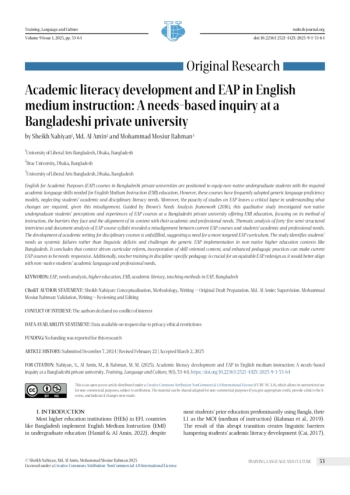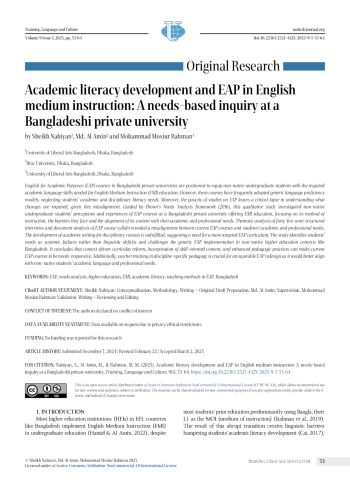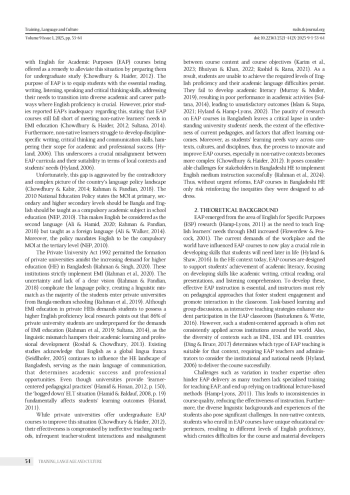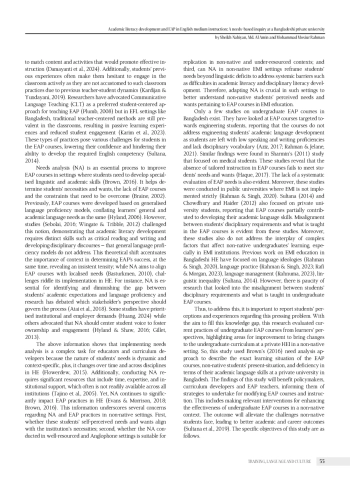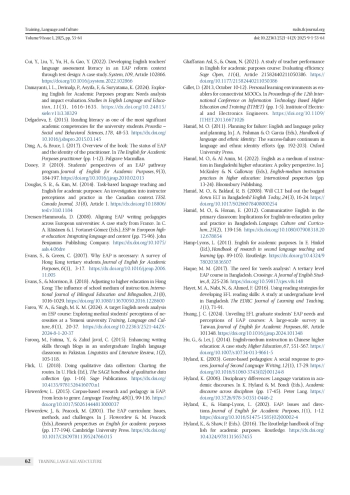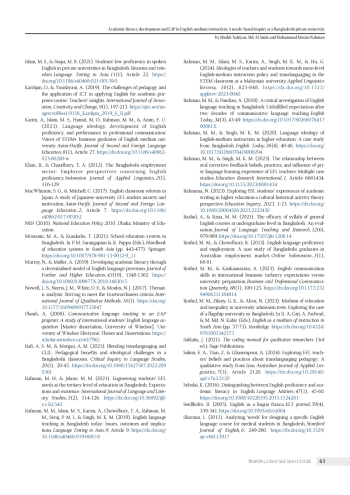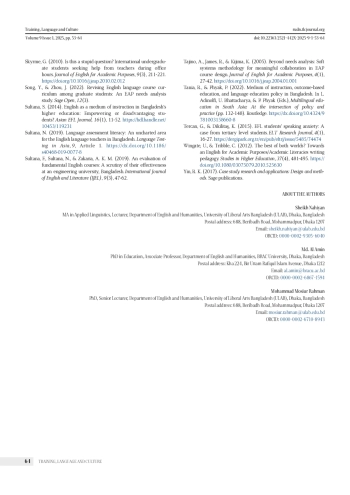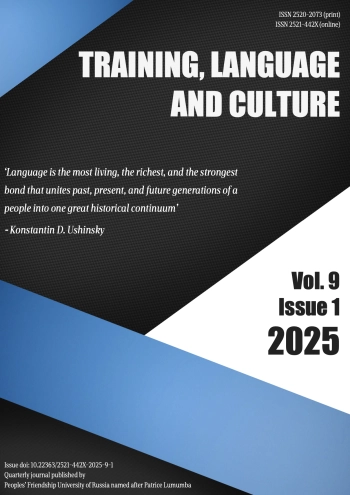English for Academic Purposes (EAP) courses in Bangladeshi private universities are positioned to equip non-native undergraduate students with the required academic language skills needed for English Medium Instruction (EMI) education. However, these courses have frequently adopted generic language proficiency models, neglecting students’ academic and disciplinary literacy needs. Moreover, the paucity of studies on EAP leaves a critical lapse in understanding what changes are required, given this misalignment. Guided by Brown’s Needs Analysis framework (2016), this qualitative study investigated non-native undergraduate students’ perceptions and experiences of EAP courses at a Bangladeshi private university offering EMI education, focusing on its method of instruction, the barriers they face and the alignment of its content with their academic and professional needs. Thematic analysis of forty-five semi-structured interviews and document analysis of EAP course syllabi revealed a misalignment between current EAP courses and students’ academic and professional needs. The development of academic writing for disciplinary courses is unfulfilled, suggesting a need for a more targeted EAP curriculum. The study identifies students’ needs as systemic failures rather than linguistic deficits and challenges the generic EAP implementation in non-native higher education contexts like Bangladesh. It concludes that context-driven curricular reform, incorporation of skill-oriented content, and enhanced pedagogic practices can make current EAP courses to be needs-responsive. Additionally, teacher training in discipline-specific pedagogy is crucial for an equitable EAP redesign as it would better align with non-native students’ academic language and professional needs.
Идентификаторы и классификаторы
Most higher education institutions (HEIs) in EFL countries like Bangladesh implement English Medium Instruction (EMI) in undergraduate education (Hamid & Al Amin, 2022), despite most students’ prior education predominantly using Bangla, their L1 as the MOI (medium of instruction) (Rahman et al., 2019).
Список литературы
1. Alam, M. R., Islam, M. S., Ansarey, D., Rana, M. M., Milon, M. R. K., Halim, H. A.,... & Rashid, A. (2024). Unveiling the professional identity construction of in-service university English language teachers: Evidence from Bangladesh. Ampersand, 12, Article 100178. DOI: 10.1016/j.amper.2024.100178
2. Ali, M. M., & Hamid, M. O. (2020). Teaching English to the test: Why does negative washback exist within secondary education in Bangladesh? Language Assessment Quarterly, 17(2), 129-146. DOI: 10.1080/15434303.2020.1717495 EDN: SZKLRP
3. Ali, M. M., & Walker, A. L. (2014). ‘Bogged down’ ELT in Bangladesh: Problems and policy. Investigating some problems that encumber ELT in an EFL context. English Today, 30(2), 33-38. DOI: 10.1017/S0266078414000108
4. Arias-Contreras, C., & Moore, P. J. (2022). The role of English language in the field of agriculture: A needs analysis. English for Specific Purposes, 65, 95-106. EDN: ZTIQRP
5. Arnó-Macià, E., Aguilar-Pérez, M., & Tatzl, D. (2020). Engineering students’ perceptions of the role of ESP courses in internationalized universities. English for Specific Purposes, 58, 58-74. DOI: 10.1016/j.esp.2019.12.001 EDN: QTEAPV
6. Astalin, P. K. (2013). Qualitative research designs: A conceptual framework. International Journal of Social Science & Interdisciplinary Research, 2(1), 118-124.
7. Atai, M. R., Babaii, E., & Lotfi Gaskaree, B. (2018). A narrative study of in-service EAP teachers’ cognition on language teacher role identities. Iranian Journal of Language Teaching Research, 6(2), 97-115. DOI: 10.30466/ijltr.2018.120562
8. Aziz, J. (2017). Challenges while teaching English in the social science classroom: A Bangladesh perspective. International Journal of English Language Education, 5(1), 33-41. DOI: 10.5296/ijele.v5i1.10567
9. Basturkmen, H. (2010). Developing courses in English for specific purposes. Palgrave Macmillan.
10. Basturkmen, H., & Wette, R. (2016). English for academic purposes. In G. Hall (Ed.), The Routledge handbook of English language teaching (pp. 164-176). Routledge.
11. Bhuiyan, M. S. S., & Khan, M. E. I. (2022). Effectiveness of existing language courses and classroom tactics for ELT at the engineering universities in Bangladesh. Journal of Language Teaching and Research, 13(3), 627-637. DOI: 10.17507/jltr.1303.19 EDN: UWWLEJ
12. Bosuwon, T., & Woodrow, L. (2009). Developing a problem-based course based on needs analysis to enhance English reading ability of Thai undergraduate students. RELC Journal, 40(1), 42-64. DOI: 10.1177/0033688208101453
13. Bowen, G. A. (2009). Document analysis as a qualitative research method. Qualitative Research Journal, 9(2), 27-40. DOI: 10.3316/QRJ0902027
14. Braine, G. (2002). Academic literacy and the nonnative speaker graduate student. Journal of English for Academic Purposes, 1(1), 59-68. DOI: 10.1016/S1475-1585(02)00006-1
15. Brown, J. D. (2016). Introducing needs analysis and English for specific purposes. Routledge.
16. Cai, L. J. (2017). Students’ perceptions of academic writing: A needs analysis of EAP in China. In K. Kimura & J. Middlecamp (Eds.), Asian-focused ELT research and practice: Voices from the far edge (pp. 127-151). Phnom Penh.
17. Cao, Y., & Xiao, R. (2013). A multi-dimensional contrastive study of English abstracts by native and non-native writers. Corpora, 8(2), 209-234. DOI: 10.3366/cor.2013.0041
18. Chowdhury, R., & Kabir, A. H. (2014). Language wars: English education policy and practice in Bangladesh. Multilingual Education, 4, Article 21. DOI: 10.1186/s13616-014-0021-2
19. Chowdhury, T. A., & Haider, M. Z. (2012). A need-based evaluation of the EAP courses for the pharmacy students in the University of Asia Pacific (UAP), Bangladesh. Asian Social Science, 8(15), 93-107. DOI: 10.5539/ass.v8n15p93
20. Copland, F., Davis, M., Garton, S., & Mann, S. (2016). Investigating NEST schemes around the world: Supporting NEST/LET collaborative practices. British Council.
21. Creswell, J. W. (2012). Educational research: Planning, conducting, and evaluating quantitative and qualitative research (4th ed.). Pearson Education.
22. Creswell, J. W., & Creswell, J. D. (2017). Research design: Qualitative, quantitative, and mixed methods approaches. Sage publications.
23. Creswell, J. W., & Poth, C. N. (2016). Qualitative inquiry and research design: Choosing among five approaches. Sage publications.
24. Crosthwaite, P. (2016). A longitudinal multidimensional analysis of EAP writing: Determining EAP course effectiveness. Journal of English for Academic Purposes, 22, 166-178. DOI: 10.1016/j.jeap.2016.04.005
25. Cui, Y., Liu, Y., Yu, H., & Gao, Y. (2022). Developing English teachers’ language assessment literacy in an EAP reform context through test design: A case study. System, 109, Article 102866. DOI: 10.1016/j.system.2022.102866
26. Damayanti, I. L., Derinalp, P., Asyifa, F., & Suryatama, K. (2024). Exploring English for Academic Purposes program: Needs analysis and impact evaluation. Studies in English Language and Education, 11(3), 1616-1635. DOI: 10.24815/siele.v11i3.38329 EDN: KKIWRQ
27. Delgadova, E. (2015). Reading literacy as one of the most significant academic competencies for the university students. Procedia - Social and Behavioral Sciences, 178, 48-53. DOI: 10.1016/j.sbspro.2015.03.145
28. Ding, A., & Bruce, I. (2017). Overview of the book: The status of EAP and the identity of the practitioner. In The English for Academic Purposes practitioner (pp. 1-12). Palgrave Macmillan.
29. Dooey, P. (2010). Students’ perspectives of an EAP pathway program. Journal of English for Academic Purposes, 9(3), 184-197. DOI: 10.1016/j.jeap.2010.02.013
30. Douglas, S. R., & Kim, M. (2014). Task-based language teaching and English for academic purposes: An investigation into instructor perceptions and practice in the Canadian context. TESL Canada Journal, 31(8), Article 1. DOI: 10.18806/tesl.v31i0.1184
31. Dressen-Hammouda, D. (2008). Aligning EAP writing pedagogies across European universities: A case study from France. In C. A. Räisänen & I. Fortanet-Gómez (Eds.), ESP in European higher education: Integrating language and content (pp. 75-96). John Benjamins Publishing Company. DOI: 10.1075/aals.4.06dre
32. Evans, S., & Green, C. (2007). Why EAP is necessary: A survey of Hong Kong tertiary students. Journal of English for Academic Purposes, 6(1), 3-17. DOI: 10.1016/j.jeap.2006.11.005
33. Evans, S., & Morrison, B. (2018). Adjusting to higher education in Hong Kong: The influence of school medium of instruction. International Journal of Bilingual Education and Bilingualism, 21(8), 1016-1029. DOI: 10.1080/13670050.2016.1228600
34. Farea, W. A., & Singh, M. K. M. (2024). A target English needs analysis on ESP course: Exploring medical students’ perceptions of necessities at a Yemeni university. Training, Language and Culture, 8(1), 20-37. DOI: 10.22363/2521-442X-2024-8-1-20-37 EDN: YUSOJB
35. Farooq, M., Fatima, Y., & Zahid Javid, C. (2015). Enhancing writing skills through blogs in an undergraduate English language classroom in Pakistan. Linguistics and Literature Review, 1(2), 105-118.
36. Flick, U. (2018). Doing qualitative data collection: Charting the routes. In U. Flick (Ed.), The SAGE handbook of qualitative data collection (pp. 1-16). Sage Publications. DOI: 10.4135/9781526416070.n1
37. Flowerdew, L. (2015). Corpus-based research and pedagogy in EAP: From lexis to genre. Language Teaching, 48(1), 99-116. DOI: 10.1017/S0261444813000037
38. Flowerdew, J., & Peacock, M. (2001). The EAP curriculum: Issues, methods, and challenges. In J. Flowerdew & M. Peacock (Eds.), Research perspectives on English for academic purposes (pp. 177-194). Cambridge University Press. DOI: 10.1017/CBO9781139524766.015
39. Ghaffarian Asl, S., & Osam, N. (2021). A study of teacher performance in English for academic purposes course: Evaluating efficiency. Sage Open, 11(4), Article 21582440211050386. DOI: 10.1177/21582440211050386
40. Gillet, D. (2013, October 10-12). Personal learning environments as enablers for connectivist MOOCs. In Proceedings of the 12th International Conference on Information Technology Based Higher Education and Training (ITHET) (pp. 1-5). Institute of Electrical and Electronics Engineers. DOI: 10.1109/ITHET.2013.6671026
41. Hamid, M. O. (2011). Planning for failure: English and language policy and planning. In J. A. Fishman & O. Garcia (Eds.), Handbook of language and ethnic identity: The success-failure continuum in language and ethnic identity efforts (pp. 192-203). Oxford University Press.
42. Hamid, M. O., & Al Amin, M. (2022). English as a medium of instruction in Bangladeshi higher education: A policy perspective. In J. McKinley & N. Galloway (Eds.), English-medium instruction practices in higher education: International Pespectives (pp. 13-24). Bloomsbury Publishing.
43. Hamid, M. O., & Baldauf, R. B. (2008). Will CLT bail out the bogged down ELT in Bangladesh? English Today, 24(3), 16-24. DOI: 10.1017/S0266078408000254
44. Hamid, M. O., & Honan, E. (2012). Communicative English in the primary classroom: Implications for English-in-education policy and practice in Bangladesh. Language, Culture and Curriculum, 25(2), 139-156. DOI: 10.1080/07908318.2012.678854
45. Hamp-Lyons, L. (2011). English for academic purposes. In E. Hinkel (Ed.), Handbook of research in second language teaching and learning (pp. 89-105). Routledge. DOI: 10.4324/9780203836507
46. Haque, M. M. (2017). The need for ‘needs analysis’: A tertiary level EAP course in Bangladesh. Crossings: A Journal of English Studies, 8, 225-236. DOI: 10.59817/cjes.v8i.148
47. Hayet, M. A., Nabi, N., & Ahmed, F. (2016). Using reading strategies for developing EFL reading skills: A study at undergraduate level in Bangladesh. The EDRC Journal of Learning and Teaching, 1(1), 71-91.
48. Huang, J. C. (2024). Unveiling EFL graduate students’ EAP needs and perceptions of EAP courses: A large-scale survey in Taiwan. Journal of English for Academic Purposes, 68, Article 101348. DOI: 10.1016/j.jeap.2024.101348
49. Hu, G., & Lei, J. (2014). English-medium instruction in Chinese higher education: A case study. Higher Education, 67, 551-567. DOI: 10.1007/s10734-013-9661-5 EDN: WMXSOH
50. Hyland, K. (2003). Genre-based pedagogies: A social response to process. Journal of Second Language Writing, 12(1), 17-29. DOI: 10.1016/S1060-3743(02)00124-8
51. Hyland, K. (2006). Disciplinary differences: Language variation in academic discourses. In K. Hyland & M. Bondi (Eds.), Academic discourse across disciplines (pp. 17-45). Peter Lang. DOI: 10.3726/978-3-0351-0446-2
52. Hyland, K., & Hamp-Lyons, L. (2002). EAP: Issues and directions. Journal of English for Academic Purposes, 1(1), 1-12. DOI: 10.1016/S1475-1585(02)00002-4
53. Hyland, K., & Shaw, P. (Eds.). (2016). The Routledge handbook of English for academic purposes. Routledge. DOI: 10.4324/9781315657455
54. Islam, M. S., & Stapa, M. B. (2021). Students’ low proficiency in spoken English in private universities in Bangladesh: Reasons and remedies. Language Testing in Asia, 11(1), Article 22. DOI: 10.1186/s40468-021-00139-0
55. Kardijan, D., & Yundayani, A. (2019). The challenges of pedagogy and the application of ICT in applying English for academic purposes course: Teachers’ insights. International Journal of Innovation, Creativity and Change, 9(1), 197-213. https://ijicc.net/images/vol9iss1/9118_Kardijan_2019_E_R.pdf.
56. Karim, A., Islam, M. S., Hamid, M. O., Rahman, M. M., & Amin, E. U. (2023). Language ideology, development of English proficiency, and performance in professional communication: Voices of STEM+ business graduates of English medium university. Asian-Pacific Journal of Second and Foreign Language Education, 8(1), Article 27. DOI: 10.1186/s40862-023-00200-w
57. Khan, R., & Chaudhury, T. A. (2012). The Bangladeshi employment sector: Employer perspectives concerning English proficiency. Indonesian Journal of Applied Linguistics, 2(1), 116-129.
58. MacWhinnie, S. G., & Mitchell, C. (2017). English classroom reforms in Japan: A study of Japanese university EFL student anxiety and motivation. Asian-Pacific Journal of Second and Foreign Language Education, 2, Article 7. DOI: 10.1186/s40862-017-0030-2
59. NEP. (2010). National Education Policy 2010. Dhaka: Ministry of Education.
60. Mousumi, M. A., & Kusakabe, T. (2021). School education system in Bangladesh. In P. M. Sarangapani & R. Pappu (Eds.), Handbook of education systems in South Asia (pp. 443-477). Springer. DOI: 10.1007/978-981-15-0032-9_11
61. Murray, N., & Muller, A. (2019). Developing academic literacy through a decentralised model of English language provision. Journal of Further and Higher Education, 43(10), 1348-1362. DOI: 10.1080/0309877X.2018.1483015
62. Nowell, L. S., Norris, J. M., White, D. E., & Moules, N. J. (2017). Thematic analysis: Striving to meet the trustworthiness criteria. International Journal of Qualitative Methods, 16(1). DOI: 10.1177/1609406917733847
63. Plumb, A. (2008). Communicative language teaching in an EAP program: A study of international students’ English language acquisition [Master dissertation, University of Windsor]. University of Windsor Electronic Theses and Dissertations. https://scholar.uwindsor.ca/etd/7962.
64. Rafi, A. S. M., & Morgan, A. M. (2023). Blending translanguaging and CLIL: Pedagogical benefits and ideological challenges in a Bangladeshi classroom. Critical Inquiry in Language Studies, 20(1), 20-45. DOI: 10.1080/15427587.2022.2090361 EDN: VTHSCW
65. Rahman, M. H., & Jelane, M. M. (2021). Engineering students’ EFL needs at the tertiary level of education in Bangladesh: Expectations and existence. International Journal of Language and Literary Studies, 3(2), 114-126. DOI: 10.36892/ijlls.v3i2.542 EDN: UYGDLJ
66. Rahman, M. M., Islam, M. S., Karim, A., Chowdhury, T. A., Rahman, M. M., Seraj, P. M. I., & Singh, M. K. M. (2019). English language teaching in Bangladesh today: Issues, outcomes and implications. Language Testing in Asia, 9, Article 9. DOI: 10.1186/s40468-019-0085-8
67. Rahman, M. M., Islam, M. S., Karim, A., Singh, M. K. M., & Hu, G. (2024). Ideologies of teachers and students towards meso-level English-medium instruction policy and translanguaging in the STEM classroom at a Malaysian university. Applied Linguistics Review, 16(2), 825-848. DOI: 10.1515/applirev-2023-0040 EDN: RDUSSI
68. Rahman, M. M., & Pandian, A. (2018). A critical investigation of English language teaching in Bangladesh: Unfulfilled expectations after two decades of communicative language teaching. English Today, 34(3), 43-49. DOI: 10.1017/S026607841700061X
69. Rahman, M. M., & Singh, M. K. M. (2020). Language ideology of English-medium instruction in higher education: A case study from Bangladesh. English Today, 36(4), 40-46. DOI: 10.1017/S0266078419000294
70. Rahman, M. M., & Singh, M. K. M. (2023). The relationship between oral corrective feedback beliefs, practices, and influence of prior language learning experience of EFL teachers: Multiple case studies. Education Research International, 1, Article 6681434. DOI: 10.1155/2023/6681434
71. Rahnuma, N. (2023). Exploring ESL students’ experiences of academic writing in higher education-a cultural historical activity theory perspective. Education Inquiry, 2023, 1-23. DOI: 10.1080/20004508.2023.2222450
72. Rashid, A., & Rana, M. M. (2021). The efficacy of syllabi of general English courses at undergraduate level in Bangladesh: An evaluation. Journal of Language Teaching and Research, 12(6), 979-989. DOI: 10.17507/jltr.1206.14 EDN: IHUKRS
73. Roshid, M. M., & Chowdhury, R. (2013). English language proficiency and employment: A case study of Bangladeshi graduates in Australian employment market. Online Submission, 3(1), 68-81.
74. Roshid, M. M., & Kankaanranta, A. (2023). English communication skills in international business: Industry expectations versus university preparation. Business and Professional Communication Quarterly, 88(1), 100-125. DOI: 10.1177/23294906231184814 EDN: HZORVK
75. Roshid, M. M., Zilany, G. K., & Afroz, N. (2023). Medium of education and inequality in university admission tests: Exploring the case of a flagship university in Bangladesh. In R. A. Giri, A. Padwad, & M. Md. N. Kabir (Eds.), English as a medium of instruction in South Asia (pp. 57-75). Routledge. DOI: 10.4324/9781003342373
76. Saldaña, J. (2021). The coding manual for qualitative researchers (3rd ed.). Sage Publications.
77. Salimi, E. A., Tian, Z., & Ghasempour, A. (2024). Exploring EFL teachers’ beliefs and practices about translanguaging pedagogy: A qualitative study from Iran. Australian Journal of Applied Linguistics, 7(3), Article 2120. DOI: 10.29140/ajal.v7n3.2120
78. Sebolai, K. (2016). Distinguishing between English proficiency and academic literacy in English. Language Matters, 47(1), 45-60. DOI: 10.1080/10228195.2015.1124281
79. Seidlhofer, B. (2005). English as a lingua franca. ELT journal, 59(4), 339-341. DOI: 10.1093/elt/cci064 EDN: INYXVZ
80. Sharmin, L. (2011). Analyzing ‘needs’ for designing a specific English language course for medical students in Bangladesh. Stamford Journal of English, 6, 249-260. DOI: 10.3329/sje.v6i0.13917
81. Skyrme, G. (2010). Is this a stupid question? International undergraduate students seeking help from teachers during office hours. Journal of English for Academic Purposes, 9(3), 211-221. DOI: 10.1016/j.jeap.2010.02.012
82. Song, Y., & Zhou, J. (2022). Revising English language course curriculum among graduate students: An EAP needs analysis study. Sage Open, 12(3).
83. Sultana, S. (2014). English as a medium of instruction in Bangladesh’s higher education: Empowering or disadvantaging students? Asian EFL Journal, 16(1), 11-52. http://hdl.handle.net/10453/119231.
84. Sultana, N. (2019). Language assessment literacy: An uncharted area for the English language teachers in Bangladesh. Language Testing in Asia, 9, Article 1. DOI: 10.1186/s40468-019-0077-8
85. Sultana, F., Sultana, N., & Zakaria, A. K. M. (2019). An evaluation of fundamental English courses: A scrutiny of their effectiveness at an engineering university, Bangladesh. International Journal of English and Literature (IJEL), 9(3), 47-62.
86. Tajino, A., James, R., & Kijima, K. (2005). Beyond needs analysis: Soft systems methodology for meaningful collaboration in EAP course design. Journal of English for Academic Purposes, 4(1), 27-42. DOI: 10.1016/j.jeap.2004.01.001
87. Tania, R., & Phyak, P. (2022). Medium of instruction, outcome-based education, and language education policy in Bangladesh. In L. Adinolfi, U. Bhattacharya, & P. Phyak (Eds.), Multilingual education in South Asia: At the intersection of policy and practice (pp. 132-148). Routledge. DOI: 10.4324/9781003158660-8
88. Tercan, G., & Dikilitaş, K. (2015). EFL students’ speaking anxiety: A case from tertiary level students. ELT Research Journal, 4(1), 16-27. https://dergipark.org.tr/en/pub/eltrj/issue/5485/74474.
89. Wingate, U., & Tribble, C. (2012). The best of both worlds? Towards an English for Academic Purposes/Academic Literacies writing pedagogy. Studies in Higher Education, 37(4), 481-495. DOI: 10.1080/03075079.2010.525630
90. Yin, R. K. (2017). Case study research and applications: Design and methods. Sage publications.
Выпуск
Другие статьи выпуска
In a thirty-year career as a teacher of English as a foreign and second language, Nik Peachey set up his own online system for producing weekly lesson plans for teachers, focusing on social issues and addressing areas of language use of special value to language teachers wanting to introduce new topics and activities to their classes at different levels of proficiency. Like many of his colleagues, he has moved beyond the use of the computer and the Internet to produce and circulate lesson plans and now has published an online book on the role of artificial intelligence and its applications, such as ChatGPT, in language learning and teaching. Entitled The Manual of AI-Mediated Autonomous Teacher Development, the book is available online. Nik Peachey takes teachers of English through the theory and practice of artificial intelligence in a clear, simple and non-scientific approach which is adaptable to all teachers of foreign and second languages helping them create and develop new teaching materials to interest and involve their students in the learning process.
The study aims to examine how movie titles are translated from English to Vietnamese under the light of the translation methods proposed by Newmark (1988). To fulfil this research objective, the researcher uses a linguistic corpus consisting of 83 pairs of movie titles collected randomly from various sources. Two research methods are employed, including discourse analysis to analyse the linguistic components used in the original and translated titles and translation comparative to compare the linguistic and semantic similarities and differences between the two versions to identify what methods have been used in each title translation. The research findings show that of the eight methods presented by Newmark (1988), only five are employed, including faithful translation, semantic translation, idiomatic translation, free translation and adaptation, together with the two additional ones, including keeping the title unchanged and creating a new title, of which faithful translation has the highest frequency of use, while the least common method is idiomatic translation. The findings indicate that the choice of translation methods depends on the text types and translators’ consideration of the linguistic, semantic and pragmatic transfer in the translation process. These findings partly align with the earlier research of Newmark and other scholars, thereby further consolidating the theories related to translation methods while some new findings are identified as the contributions of this study to the research topic. Based on the findings, some implications have been made on how to translate movie titles in general and other text types in particular.
The evolution of musical terminology is a dynamic process influenced by historical, linguistic and social factors. While initially confined to professional discourse, musical terms have been increasingly used in non-professional contexts, necessitating further investigation into this phenomenon. This study aims to analyse the development of English musical terminology, focusing on its transformation from specialised technical vocabulary to broader cultural and communicative usage. The research employs a combination of comparative-historical analysis, textual analysis and lexicographic examination. Drawing upon sources including seminal works by Charles Ives, Charles Stanford, John Mauceri and Norman Lebrecht, the study explores how musical terms function across genres and registers. The findings reveal three primary categories of musical terms: universal, unique and author. Universal terms maintain consistent meanings across musical traditions, unique terms emerge from specific musical schools and authorial terms reflect individual creativity. The research also highlights how determinologisation and dissemination processes influence the reinterpretation of musical terms in non-professional texts. The implications of this study emphasise the dynamic role of musical terminology as a bridge between professional and non-professional communication, implying its significance in both linguistic theory and global culture. The findings contribute to a deeper understanding of terminological adaptation in evolving communicative landscapes and pave the way to further research into the role of musical terms in interdisciplinary contexts.
Anxiety is a multifaceted phenomenon that necessitates a systematic approach to its examination by delving deeper into the experiences of those who encounter it. The study used a mixed method design to address teacher anxiety by employing questionnaires, interviews, and classroom observations based on Horwitz’s (1996) Foreign Language Teacher Anxiety Scale (FLTAS). First, the questionnaire was used to collect data. Second, interviews were conducted. Third, the observation phase took place. The study participants were 240 English language teachers (110 female and 130 male) with 2 to 5 years of experience at the tertiary level. Quantitative results indicate a great degree of teacher anxiety. Male teachers, on average, report a higher anxiety level than female counterparts on the FLTAS. As 0.000975 < 0.05, the p-value indicates that there is a statistically significant difference in mean scores between female and male teachers’ anxiety. Interviews revealed that English teachers experienced anxiety for various reasons, including unprepared lessons and a lack of language proficiency, fear of negative evaluation, a sense of unpreparedness for class, anxiety about making mistakes, the challenges faced by language teachers in managing the classroom, and uncertainty about language skills. An analysis of classroom observations from 10 classes yielded that most teachers harboured apprehension about being observed, struggled to manage a large number of students in their English classes, ranging from 150 to 250 students, spoke at a rapid pace, and frequently employed the technique of avoiding student inquiries during the teaching process. The current research concludes with future recommendations to minimise teacher anxiety in teaching practices by engaging them in pre and post-professional training.
This study investigates the role of deictic expressions in the IELTS speaking test, addressing a gap in research on how test-takers across proficiency levels use deixis in spoken language assessment. While previous studies have examined general discourse features in language testing, little attention has been given to the frequency, functions, and distribution of deixis in assessing spoken proficiency. The study analysed a corpus of 30 IELTS speaking test transcripts, covering proficiency levels from low-intermediate to advanced. Using Levinson’s classification of deixis, the study employed quantitative frequency analysis and qualitative discourse analysis to examine variations in the use of personal, temporal, and spatial deixis. The findings revealed that personal deixis was the most frequently used, followed by temporal and spatial deixis. However, the results of One-Way ANOVA test showed no significant differences in deixis usage across proficiency levels. These findings contribute to English language teaching and assessment by highlighting how deixis functions in test-taker discourse, offering insights for IELTS preparation and speaking proficiency evaluation. The study indicates the need for further exploration of discourse features in language assessment.
English is the dominant medium of instruction for numerous university programmes across the Arab Gulf. While a growing body of research examines learners’ attitudes towards English Medium Instruction (EMI), issues of language preference/use have received far less attention. The research reported here sought to redress this imbalance by examining the domain-based language preferences, use, and beliefs of English majors at Oman’s national university. A mixed methods approach was employed involving the administration of a 35-item questionnaire to 120 English majors and one-on-one semi-structured interviews with 13 participants. Descriptive analysis, Pearson’s chi-squared test, and Cramer’s V test were used to examine questionnaire data, while interview transcripts were analysed thematically before data triangulation was performed. Findings indicate respondents preferred and used English for academics and intended careers, Arabic for familial interactions, and both English and Arabic or English by itself to talk about feelings and beliefs. English and Arabic were almost equally preferred for identity representation, with a significant minority of respondents expressing a desire to study their majors in Arabic. Although gender and English proficiency were not found to be related to beliefs about language importance, Arabic proficiency had a moderate, statistically significant association. Arab students employing English to express cultural beliefs and identities has not been widely reported in the existing literature. Results suggest that, despite evidence of emerging bilingualism in some domains, reform to tertiary-level language of instruction policies and planning in the region and similar contexts worldwide, including by offering Arabic Medium Instruction options, may be necessary to ensure effective education provision.
Intensifiers play a crucial role in everyday communication, varying in frequency, function, and socio-pragmatic significance across languages. However, gender-based variation in their use remains underexplored. This study examines intensifier usage among native speakers of English and Bahasa Indonesia, focusing on male and female speakers in spontaneous, face-threatening contexts. Data were collected through Elicited Oral Responses (EOR) from 40 university students – 20 English speakers from an Australian university and 20 Bahasa Indonesia speakers from a university in Jambi. Participants responded in their native language to an apologetic scenario in which a close friend had broken a promise. Their responses were recorded, transcribed, and analysed for intensifier frequency and type. Findings indicate that both language groups use intensifiers to amplify emotions and signal heightened face-threat. However, English speakers employed intensifiers more frequently and with greater variety than their Indonesian counterparts. Gender differences were also evident, with males and females differing in both the types and frequency of intensifiers used. This study contributes to sociolinguistics and pragmatics by elucidating gendered language use in intercultural communication. It also holds pedagogical implications for language learning, enhancing awareness of how intensifiers function in spoken discourse across cultures. This study contributes to cross-cultural pragmatics by examining differences in intensifier use between native English and Bahasa Indonesia speakers in face-threatening contexts. The findings enhance understanding of gender’s impact on intensifier use and supply information for language instruction, particularly in teaching emotional expressions in everyday conversations.
The present study presents a comparative analysis of the translation processes and outcomes of human translators, Neural Machine Translation (NMT) systems and Large Language Models (LLMs) focusing on the translation of Metaphor-related Words (MRW). The study employs various research methodologies, including product analysis, think-aloud protocols, subsequent interviews, and translation quality assessments to uncover the choice of strategies in translating MRWs by different subject groups as well as its relation with quality criterion. Human translators and LLMs tend to favour strategies such as metaphor into different metaphor (M-M2) and metaphor reduction (M→Non), while NMT systems prefer the reproduction of metaphors (M→M). LLMs demonstrate translation patterns which are more aligned with human translators, helping them achieve higher evaluation scores, though their performance remains inconsistent, particularly with novel metaphors. Additionally, human translators process metaphors by incorporating conceptual, cultural, and contextual factors, whereas LLMs tend to rely on paraphrastic approaches. Evaluation results indicate that LLMs exhibit proficiency on par with novice translators in terms of accuracy, idiomatic expression, and vividness in metaphor translation, while NMT systems fall slightly short. The study highlights the influence of translation strategies on the quality of metaphor translation and concludes that, while NMT systems and LLMs can achieve performance comparable to human translators, much larger metaphor-specific datasets supported studies are expected to validate its consistency.
Статистика статьи
Статистика просмотров за 2025 год.
Издательство
- Издательство
- РУДН
- Регион
- Россия, Москва
- Почтовый адрес
- 117198, г. Москва, ул. Миклухо-Маклая, д. 6
- Юр. адрес
- 117198, г Москва, Обручевский р-н, ул Миклухо-Маклая, д 6
- ФИО
- Ястребов Олег Александрович (РЕКТОР)
- E-mail адрес
- rector@rudn.ru
- Контактный телефон
- +7 (495) 4347027
- Сайт
- https://www.rudn.ru/
